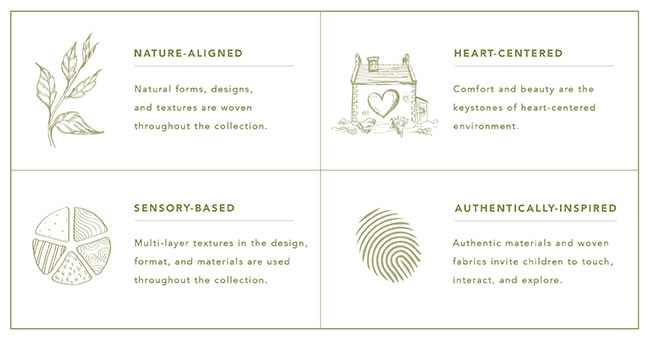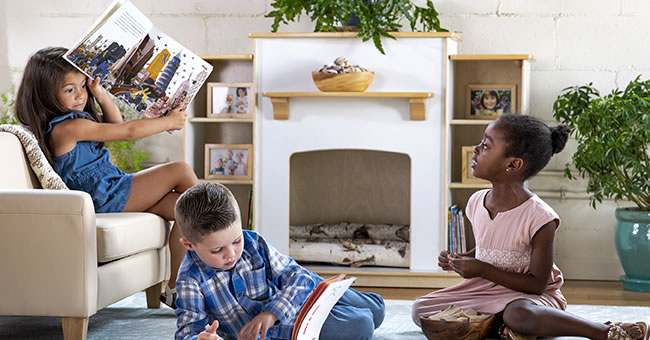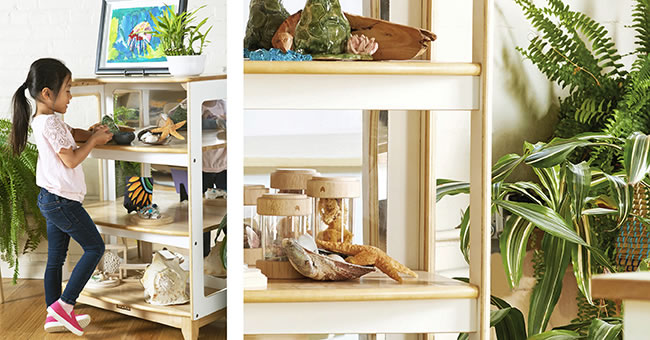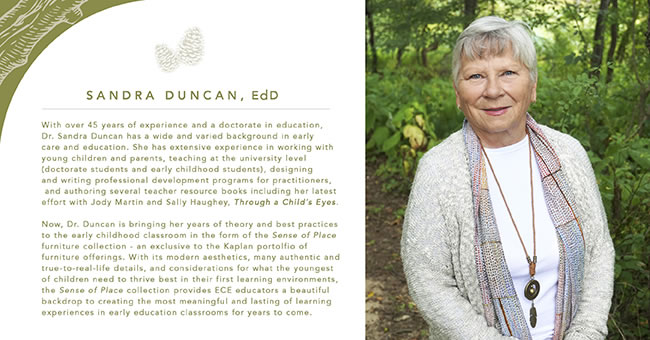
The Sense of Place preschool furniture collection is beautifully and intentionally designed to inspire preschooler's wonder and to nurture their growth and development. It not only celebrates the spirit of place but rejoices in the wonder of childhood. Woven throughout this collection are four design beliefs that I consider essential and are the underlying foundation for the creation of this spirited collection.

Scientific research is now confirming there is a significant link between young children's internal beings and their external environments. We know, for example, that bright primary colors can have a negative influence on children's behaviors and their ability to focus. We also know that our brains are wired to make connections but, in order for these connections to successfully occur, children need simplicity and organization in their environments. It is widely accepted that we all react—whether consciously or unconsciously—to the surrounding environment. Sights, sounds, smells, temperatures, over stimulation as well as under stimulation dramatically impact children's behaviors, moods, physical, and cognitive development. More significantly, research is beginning to tell us that, in order to develop positive relationships with others, the early childhood environment must meet the basic needs of young children such as safety, security, and a sense of comfort and a feeling of love. Children must feel they belong and can make important contributions to the classroom.

When creating the Sense of Place furniture collection, there was considerable thought given to the importance of fostering children's social and emotional development. I faced the challenge of incorporating into the furniture pieces ideas such as the (1) notion of children's feelings, (2) sense of place and home, and (3) everyone's longing to belong. This challenge was answered through the creation of several pieces of furniture in the collection. For example, the living room furniture with its fireplace, comfortable couch and chair, and beautiful rugs composed of nature's colors (i.e., blue and green) as well as natural patterns and designs. In addition to feeling comfort, young children feel right-at-home when they find a book and cozy-up either on the chair and couch or on the soft rugs. The fireplace mantel and bookshelves are perfect spots for children's framed artwork or photographs of children actively engaged in open-ended activities. Personalize the fireplace by using natural objects found outside such as sticks or tree bark. Make logs for pretend fires out of construction paper or foil. Search outside for sticks. Add battery-powered lights or flickering lamps to represent the soft glow of a warm fire. If participating in this type of activity, be sure to talk to the children about fire safety in real life.

Another piece of the Sense of Place furniture designed to promote children's sense of belonging includes the curio cabinet. Designed to honor children's work and to offer opportunities for them to curate their work or displays, the curio cabinet gives children a sense of belonging and accomplishment when their wonderful works of art are displayed with integrity and beauty. The reflective mirrors and open sides were specifically included so the objects on the shelves are easily placed, seen, and admired.

The farm table's benches were also a deliberate addition to the Sense of Place collection. When compared to children sitting in individual chairs, research has found that benches better promote children's socialization. When children are sitting in benches, they are more likely to "skootch" together, share materials, collaborate, and enter into conversations. Indeed, benches promote a sense of belonging or community and it is with great enthusiasm that they were included in this furniture collection.
Here are some ways you can personalize the classroom by adding a sense of belonging and comfort:
- Offer an empty space in the classroom for children to make their own. Do not share expectations or give instructions for this space—just provide it. Let the children decide what this space will be, how it is organized, and what materials are included. The children are in control of this area and adults are not welcome. It belongs to them.
- Create habitats of refuge. Although most early childhood classrooms offer at least one quiet space, this is not enough. It is important to carve out multiple habitats of refuge where children have the space as well as the time to have a little peace and quiet. These habitats do not need to take up a lot of space or time to create: Fill a sturdy medium- sized cardboard box with a soft item (i.e., small throw rug, tiny pillow, or baby blanket) and place in an out-of-the-way spot. The box should be just big enough for one child to belong and snuggle into. When the box wears out, find another one.
- Provide soft seating. Most of the chairs in an early childhood setting are hard surfaced and not exactly cozy. Soften up your room with an upholstered couch and chairs or create a place for children to belong by finding a sturdy Queen Anne's or overstuffed chair. Cut down the legs to make the chair a child's height (about 4 inches from the ground). Or, find some large, overstuffed pillows to throw in a corner for added comfort. Be sure to find pillows with removable covers for easy cleaning.


